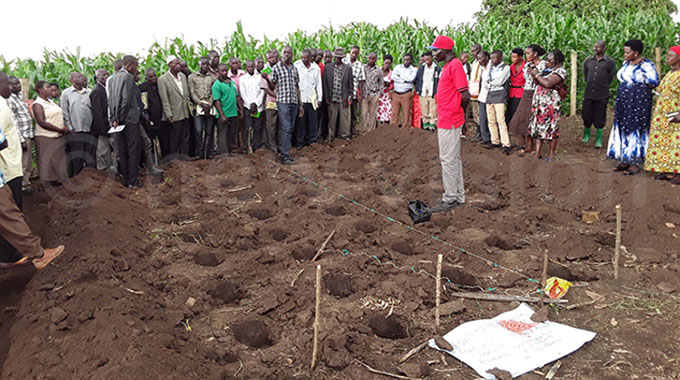‘Pfumvudza’: Path to food self-sufficiency

Rutendo Nhongonhema and Wendy Madzura
As the reality of climate change continues to sink in, particularly among smallholder farmers, there is no doubt there is need for mitigation measures to be developed to reduce its effects.
In light of this, Government and some private sector players including Seed Co, has decided to nationalise the “Pfumvudza” concept. Pfumvudza is an approach from the foundations for farming aimed at promoting the adoption of the principles of conservation agriculture.
The principles state that farmers should:
Adhere to minimum soil disturbance techniques, this means farmers should only dig a hole or planting station where they will be planting their seeds and leave the rest of the land undisturbed.
Use mulch to conserve moisture and suppress weeds during the summer season.
Be encouraged to rotate crops grown on their plots especially with a legume for soil conservation.
The Pfumvudza concept is tailor-made to benefit all farmers in Zimbabwe. The aim is to grow yields at household level as this directly impacts on the national yield level, which presently sits at between 0,5 tonnes per hectare to 0,9 tonnes per hectare, against exceptional genetics on the market with the ability to reach well above 10t/ha.
The yield gap is evidently too high; hence this concept seeks to unlock the genetic potential of the good varieties on the market through adoption of good agronomic practices.
Good agronomic practices is a term that has gained a lot of popularity in Zimbabwe, is essentially a summary of the correct use of organic and inorganic fertilisers, weed control, pest control and the general crop management practices that promote increased productivity.
The Pfumvudza concept promotes intensive farming through the utilisation of small pieces of land to increase productivity. Pfumvudza promotes a systemic approach to the adoption of good agronomic practices, thereby increasing the yields achieved on a specified plot size.
The plot layout is as follows:
- 39m (length) x 16m (width) = 624m2 (about 1/16th of a hectare)
52 lines at the following spacing — 60cm in-row and 75cm; inter-row for maize; 30cm in-row and 75cm inter-row for sorghum
Each line has 28 planting stations/holes
2 peeps are recommended per planting station which gives 56 plants per plot
At harvesting each line with the 56 cobs produces one bucket of maize grain enough to feed a standard family of 6 for one week. The 52 lines are meant to provide 52 buckets of maize grain enough to feed a standard family of six for one year.
The success of this concept lies in the ability of the farmers to observe the strict time frames set to conduct specified tasks. Soil conditioning is a key step to the attainment of high yields.
Zimbabwean soils have been seen to be highly acidic owing to poor soil conditioning and mono-cropping and as such the Pfumvudza concept seeks to promote the use of lime by farmers, initially through a recommended rate to start the adoption of the liming principle and then in preceding seasons, to promote soil sampling for precise lime and fertiliser rates.
This is in line with the goals of sustainable agriculture and precision farming. The application of lime under the Pfumvudza concept should be done soon after the digging of holes and farmers must use a fertiliser cup for application.
During winter, farmers are encouraged to harvest mulch, hole out planting stations and apply lime in the holes. Where possible, farmers are encouraged to fence out their plots so that the basins are not disturbed by livestock and wind.
Farmers are encouraged to store the stover from their harvested crops to use as mulch during the summer season as possible.
The next step is for farmers to dig holes before the onset of the summer season. The holes should not be too close to each other. Adopting integrated production systems which promote use of organic fertilisers, together with inorganic fertiliser, leads to increase in the nutrient status of the soil, while promoting soil conservation.
The Pfumvudza concept therefore encourages the use of fully decomposed manure to promote the improvement of soil structure while providing nutrients to the plant. It also promotes the use of inorganic fertilisers which include compound D with an NPK ratio of 7:14:7.
The application rate for the basal fertiliser is 5g (cup no 5) per planting station. Other fertiliser compositions that are recommended for maize production can be used but the rates of application must be adjusted to suite the nutrient composition for the crop to get the desired nutrient constitution.
The fertiliser should be applied before or at planting. In areas which receive early rains (before November 15), the planting of the Pfumvudza plot should be at the onset of the first effective rains.
Farmers can tell if they received enough rains to plant when their planting stations or holes have filled up with water. In areas that receive first rains later than November 15, farmers are encouraged to plant by the first week of November, applying 2-6 litres of water per planting station.
Once this occurs, planting commences with farmers recommended to plant three peeps per planting station as this allows them to get the desired plant population.
After two weeks, farmers must thin the field to ensure only two peeps remain per planting station. If two peeps per planting station are achieved on the 28 planting stations/holes established, then it means a farmer will have 56 cobs per line.
This brings us back to the study that showed that 56 cobs can give a farmer 1 x 20 litre bucket of shelled grain, which is enough to feed a standard family of six for one week.
The Pfumvudza plot has 52 lines which produce grain adequate to feed a family of six for the 52 weeks. The Pfumvudza concept seeks to eradicate hunger at household level by promoting intensive farming.
Under the Pfumvudza concept, it is recommended that a farmer does three plots:
Two for maize or traditional grains (sorghum, pearl millet or finger millet)
One for household consumption.
One for income.
The third plot will be for the establishment of an oilseed crop.
The success of such Government initiatives with the support of the private sector, lies in the ability to promote timely implementation of key stages of the concept, the adoption of good crop management practices that include regular scouting for insect pests and timeous control.
It also requires effective weed management, nutrition management and the use of the right climate smart genetics with the potential to give the desired yields.
A farmer need to grow varieties that are drought and disease tolerant, high yielding and with a high fertiliser use efficiency for the Pfumvudza concept to come to fruition.
#Increasing productivity through intensive, structured farming. Pfumvudza “Dhiga Ugute”
Rutendo Nhongonhema is the chief agronomist in the Ministry of Lands, Agriculture, Water and Rural Resettlement while Wendy Madzura is the head of agronomy services with Seed Co Zimbabwe.









Comments